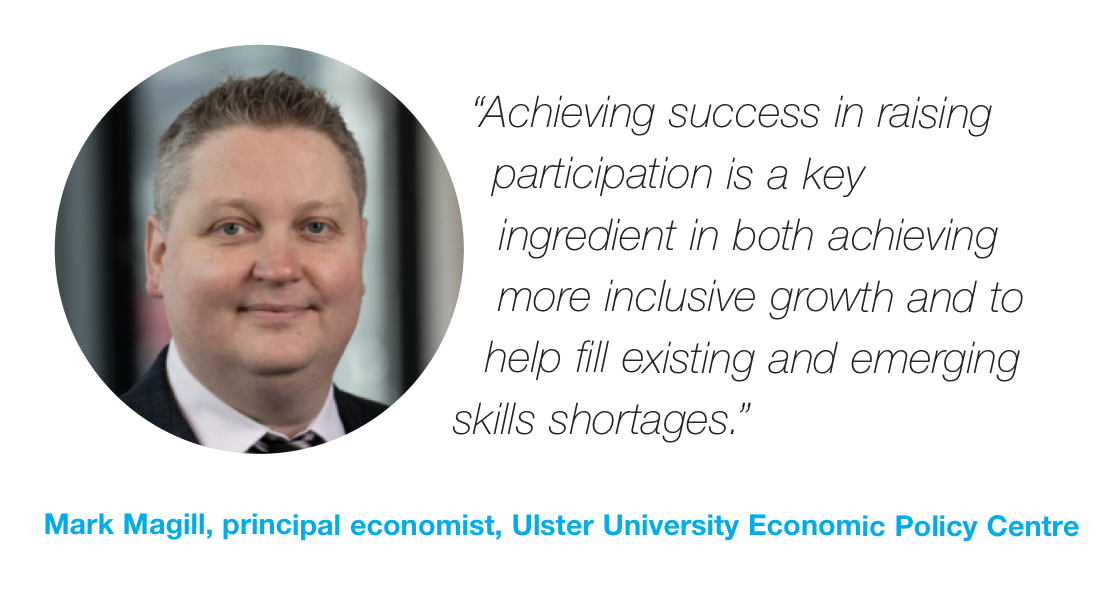Unravelling the puzzle: Tackling Northern Ireland’s talent dilemma

While it is important that policy adequately plans for jobs in the future, it is equally as important to plan for labour market participation, explains Mark Magill, principal economist at the Ulster University Economic Policy Centre.
Skills challenges are never far from the top of the list of Northern Ireland’s key public policy challenges. However, over the past few years staff shortages have become a nuisance for local employers across all sectors. In the Q1 2024 NI Chamber of Commerce Quarterly Economic Survey, 77 per cent of manufacturers and 66 per cent of service firms reported finding it difficult to get staff.
Although the share of businesses reporting recruitment difficulties has eased over the past year, a significant majority continue to report that they are unable to get access to the skills required in order to grow their businesses.
The Ulster University Economic Policy Centre (UUEPC) recently published research concluding that Northern Ireland currently has the least spare labour market capacity amongst the UK’s 12 regions. This presents a major problem by limiting the potential growth rate of the economy. A legitimate question for local employers to be asking is ‘where have all the workers gone?’

Northern Ireland’s changing demographic profile provides a partial answer. Between 1980 to 2010 the local economy was supported by Northern Ireland’s demographic dividend, whereby the working age population (those aged 16 to 64) increased, on average, by 90,000 per decade.
In the 2010s it increased by just 22,000. Local employers did not immediately feel the pinch as there was plentiful spare capacity in the labour market following the global financial crisis. Over the coming decade, the working age population is projected to grow by just 3,000.
Local employers are turning elsewhere for talent. Non-UK nationals accounted for 63 per cent of the growth in payrolled employment in 2023. Over the past two years, migrant labour accounted for all employee job growth in health, hospitality, retail and more than half of job growth in manufacturing. However, the ability of firms to import talent from abroad will be constrained following the introduction of new visa rules introduced in April 2024, raising the salary threshold to £38,700. This is significantly above the Northern Ireland median salary (£32,900 for a full-time employee) and prevents recruiting overseas labour for lower paid occupations.
The Northern Ireland unemployment rate is close to a record low, yet the number of people who are economically inactive remains higher than before the global pandemic. There are 312,000 people of working age who are economically inactive. For most of the group, work is not a realistic option. However, a number of the economically inactive ‘want to work’, and are known as ‘the hidden unemployed’. This is the largest group of unused labour in the Northern Ireland economy, numbering approximately 55,000 people.
While it is important that policy adequately plans for jobs in the future, it is equally as important to plan for labour market participation. Achieving success in raising participation is a key ingredient in both achieving more inclusive growth and to help fill existing and emerging skills shortages.
However, this is a significant challenge, and previous attempts to move this group into employment have achieved limited success. Ulster University recently launched EPIC Futures NI, a new initiative aiming to provide research and policy advice to support the hidden unemployed into fair and meaningful work.
There are also several structural issues contributing to Northern Ireland’s skills challenges. On the supply side, educational attainment has increased significantly over the past 20 years. In 2003/04 only half of school leavers achieved five GCSEs A*-C (including English and Maths) compared to four-fifths today. This shift has led to a higher proportion of school leavers undertaking tertiary level qualifications, increasing the average number of years spent in full-time education before entering the labour market.
The smaller number of low achievers at school has driven a large fall in further education qualifier numbers. This has squeezed the skills pipeline for jobs that typically recruited non-tertiary qualifiers. Compared to many of our European peers, there are significantly fewer qualifiers from professional and technical courses. This creates a ‘missing middle’ in Northern Ireland’s supply of skills and is a function of a lack of clear pathways available to school leavers considering these types of courses.
At graduate level, a high proportion of qualifiers are concentrated within a relatively narrow group of subjects. Health related subjects account for over one in five HE qualifications. Business, management and social sciences account for more than one in four graduates. However, there is a low representation of some more specialised subject areas such as creative arts and design, mathematical sciences and some STEM subject areas.
The latest NI Skills Barometer reported that Northern Ireland’s largest skills shortages are in engineering and computer science, highlighting the importance of high-quality careers advice to ensure young people make informed choices.

Northern Ireland tends to underperform internationally on lifelong learning measures, recording the lowest proportion of employees receiving training or working towards a qualification of any UK region. In a rapidly changing world, skills during formal education or in prior employment become obsolete more quickly. Therefore, lifelong learning activities become an essential instrument in addressing Northern Ireland’s competitiveness challenges.
In summary, Northern Ireland faces two distinct sets of skills challenges. The first relates to the quantum of labour supply available. In the absence of a devolved regional migration policy the Executive has limited powers to alter the ability of local businesses to import overseas labour.
Therefore, supporting the ‘hidden unemployed’ into work is the key avenue through which Northern Ireland’s labour supply can be increased. This group face multiple barriers to employment, and no single initiative is likely to achieve success without an accompanying wrap around skills policy.
The second set of challenges relate to structural issues. Notably, a lack of mid-level qualifiers, an undersupply of skills in key narrow-STEM subjects and a labour market lacking a culture of lifelong learning.
Achieving success across all aspects of the education and training system is an extremely difficult challenge. However, a failure to tackle these challenges may lead to a decade of persistent skills shortages, holding back the economic potential of the local economy.





